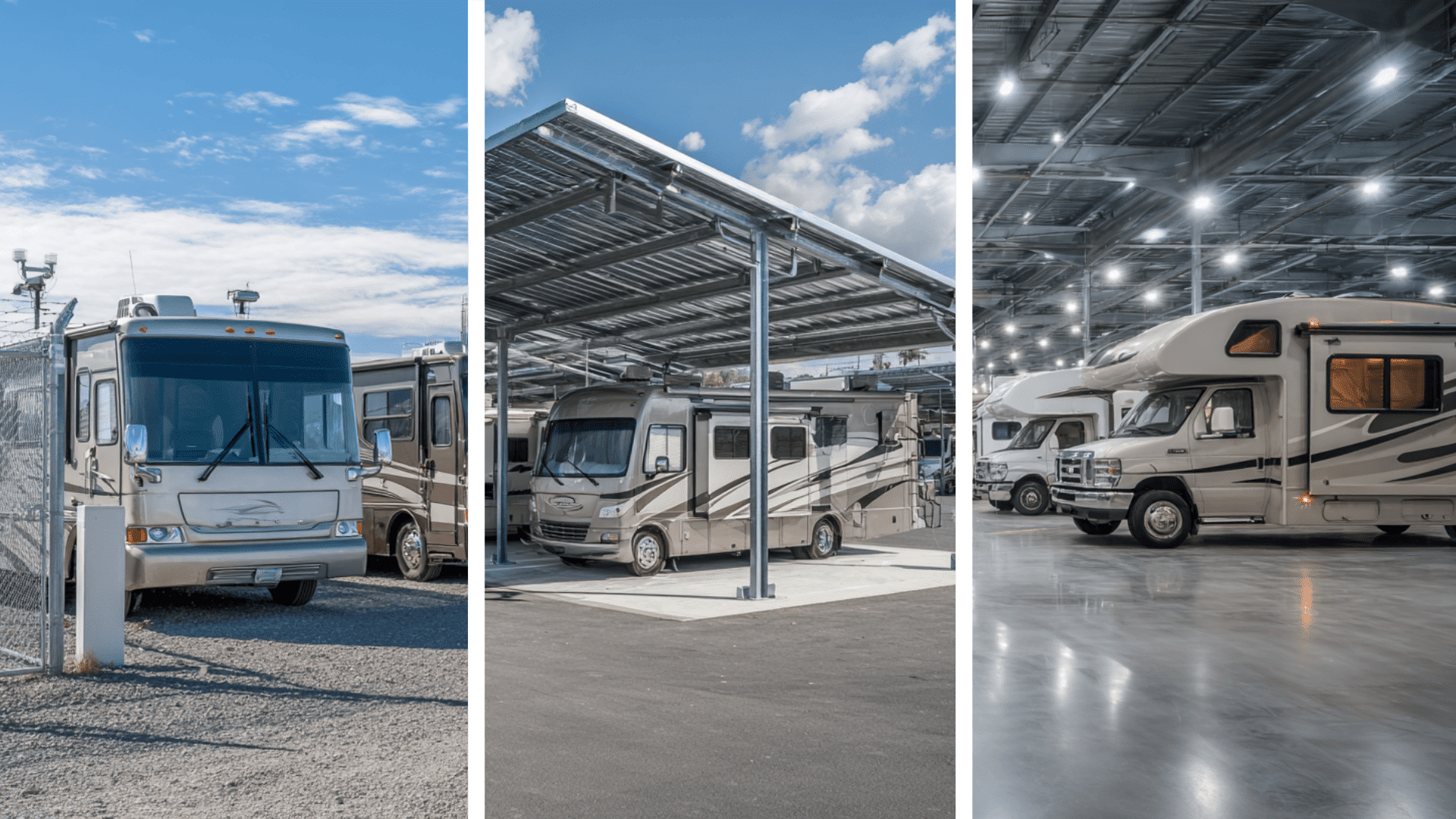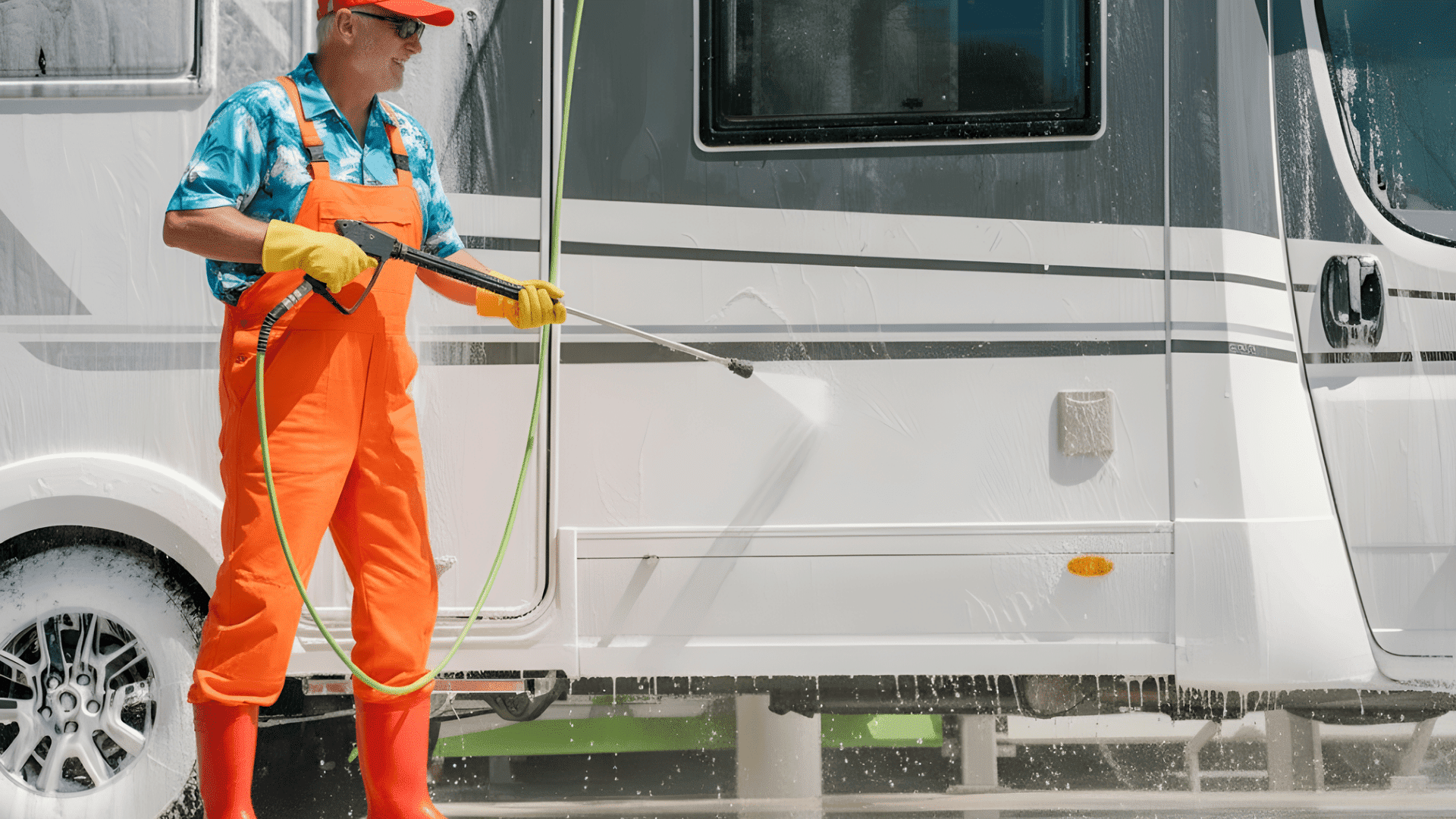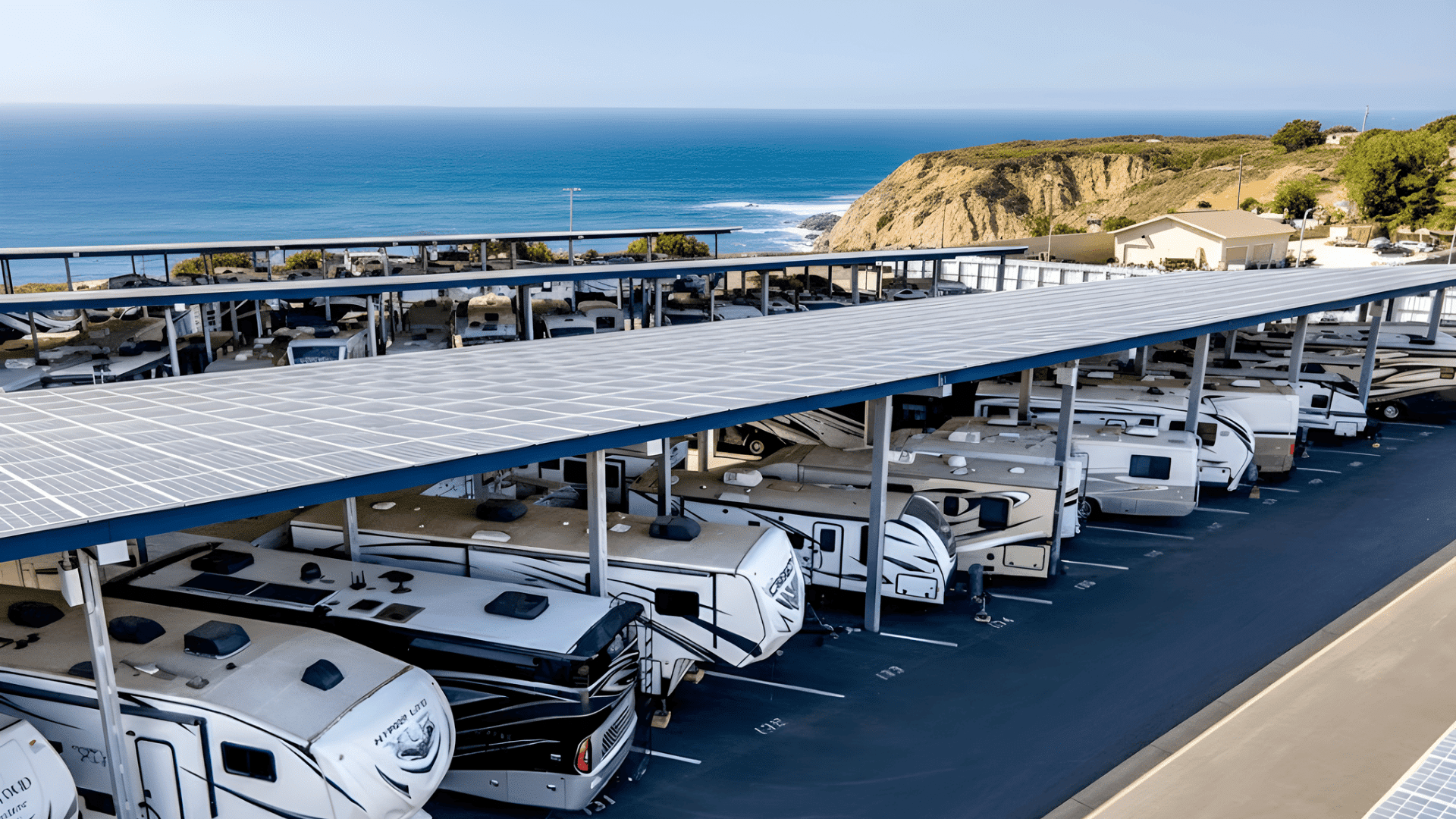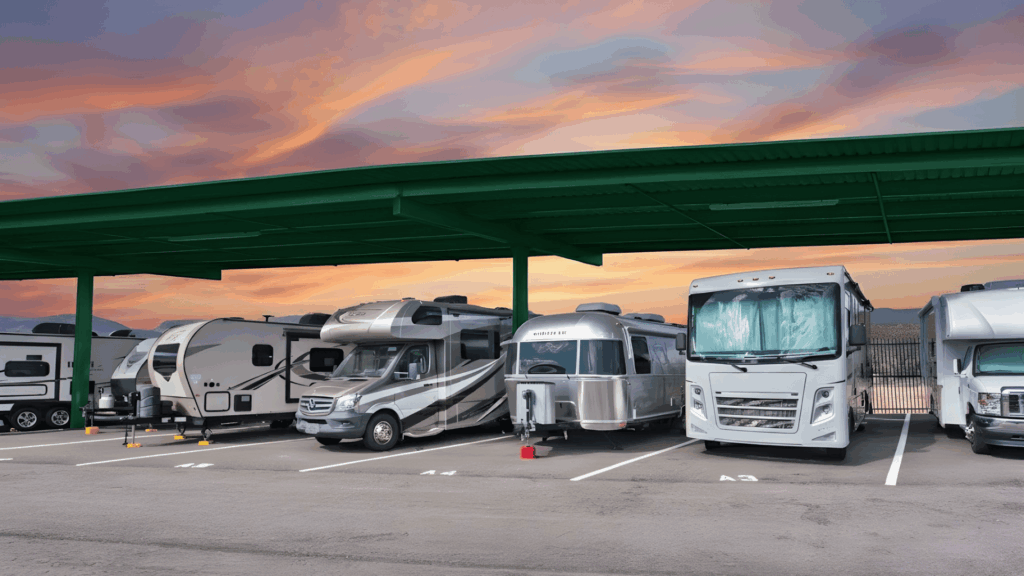Finding the right place to park your RV when it’s not in use can be tricky, especially if you’re short on space at home. That’s where outdoor RV storage comes in – it’s simple, affordable, and built for convenience.
Today, you’ll learn with me what makes outdoor storage a smart choice, how to keep your RV safe year-round, and where to find trusted spots near you.
No matter if you’re a weekend traveler or a full-time road tripper, this will help you choose the best way to protect your RV without spending more than you need.
What is Outdoor RV Storage?
Outdoor RV storage is a convenient and affordable way to park your recreational vehicle when it’s not in use.
These spaces are typically located in secure lots or storage facilities with designated parking spots for different RV sizes. Many facilities offer gated access, cameras, and on-site management for added security.
Outdoor RV storage is ideal for seasonal travelers or those without driveway space at home. It keeps your RV protected, accessible, and ready for your next road trip without crowding your property.
Types of RV Storage: Outdoor, Covered, and Indoor

Not all RV storage is the same. Each option offers a different level of protection, convenience, and price. Here’s a quick look at how they compare:
1. Outdoor (Uncovered) Storage
Outdoor storage is the most affordable option for RV owners. You’ll park in an open, paved, or gravel lot that’s usually fenced and camera-monitored.
It’s convenient and easy to access anytime, but your RV stays exposed to sunlight, rain, and snow, so proper covers and maintenance are important.
2. Covered Storage
Covered storage offers a balance between cost and protection. Your RV sits under a roof or canopy that shields it from direct sunlight and rain while still being outdoors.
It helps prevent paint fading, roof wear, and interior heat buildup, making it a great mid-tier option for regular use.
3. Indoor Storage
Indoor storage is the premium choice, giving your RV complete protection inside a secure, climate-controlled building. It prevents damage from weather, pests, and moisture, keeping your vehicle in top shape.
It’s ideal for luxury RVs, long-term storage, or anyone wanting the highest level of safety and care.
Each type suits a different budget and level of care, but outdoor storage remains the most practical choice for most RV owners. Now, let’s look at what it typically costs.
Outdoor RV Storage Costs
Outdoor RV storage offers flexible and affordable options for keeping your vehicle safe when not in use.
| Type of Outdoor Storage | Average Monthly Cost | Best For |
|---|---|---|
| Open Lot (Uncovered) | $50 – $150 | Budget-friendly storage in mild weather areas |
| Covered / Canopy Parking | $100 – $250 | RVs needing protection from sun or light rain |
| Secured Outdoor with Amenities | $150 – $300+ | Long-term storage with higher security needs |
Key Factors That Affect Price
- Location: Costs are higher in urban or high-demand regions.
- Security Features: Gated access, lighting, and cameras increase the rate.
- RV Size: Larger motorhomes take up more space and cost more to store.
- Cover Type: Covered or shaded spots are pricier than open lots.
- Access Hours: 24/7 access or premium convenience may add extra fees.
Preparing Your RV for Outdoor Storage

Getting your RV ready before storage keeps it in good shape and helps avoid costly repairs later. A bit of prep time now will save you trouble when you’re ready to travel again:
- Wash and dry thoroughly: Give your RV a good wash to remove dirt, bugs, and road salt that can cause rust or paint damage. Make sure it’s completely dry before covering it to prevent moisture buildup and mold.
- Empty tanks and disconnected batteries: Drain all water and waste tanks to avoid leaks or unpleasant smells. Unplug or remove the batteries to prevent them from draining or corroding during long storage periods.
- Apply wax and use a breathable cover: A fresh coat of wax adds an extra layer of protection from UV rays and rain. Use a breathable RV cover to keep dust and moisture out while allowing air to circulate.
- Inflate tires and secure all windows: Check that the tires are fully inflated to prevent flat spots from forming. Close and seal all windows tightly to keep out dust, moisture, and unwanted pests.
- Remove perishables and seal gaps for pest prevention: Take out all food, toiletries, and scented products that might attract insects or rodents. Look for small gaps or vents and seal them to stop critters from getting inside.
Preparing your RV properly ensures it stays clean, dry, and ready for your next trip.
Top Outdoor RV Storage in Minnesota

If you’re in Minnesota and looking for a reliable place to park your RV, several facilities offer secure outdoor storage with convenient access and fair pricing.
| Location | Facility Name | Features | Highlights |
|---|---|---|---|
| Inver Grove Heights | Inver Grove Storage Park | Gated access, spacious parking, and bright lighting. | Affordable, easy-to-manage large RVs are ideal for long-term storage. |
| Town Centre Self Storage | Secure fencing, clean facility, and smooth entry access. | Well-maintained, safe, and managed by helpful on-site staff. | |
| StorageMart | 24/7 access, fenced area, and security cameras. | Great for flexible hours and dependable customer support. | |
| Rochester | Rochester Storage Center | Clean, organized outdoor parking with gated entry and lighting. | Ideal for RVs and trailers needing extra space and safety. |
| Stor-IT, Maple Grove Road Storage | Simple outdoor RV storage near main roads. | Hassle-free, affordable, and convenient for quick parking or pickup. | |
| U-Haul Storage of Rochester | Flexible outdoor storage with online booking. | Trusted service with easy access and reliable management. |
Each of these facilities provides secure, accessible, and affordable outdoor storage options, making them excellent choices for Minnesota RV owners who value both safety and convenience.
Finding Outdoor RV Storage Near You
Finding a good storage spot nearby doesn’t have to be complicated. Start by checking trusted directories or storage networks that list verified RV facilities.
Websites like U-Haul, CubeSmart, Extra Space Storage, and OutdoorStorage.net let you compare prices, features, and availability in your area. You can also read reviews to see how secure and well-maintained each location is.
Before booking, ask about access hours, contract terms, and on-site security. Make sure the lot fits your RV’s size and offers any extras you might need, like lighting or covered parking.
Comparing a few facilities helps you find a balance between cost, location, and security that fits your needs.
Seasonal Tips for Outdoor RV Storage
Outdoor storage works year-round, but each season brings different challenges for your RV. A few seasonal habits can keep it protected no matter the weather:
- Winter: Drain all water lines and tanks to prevent freezing. Check seals, cover your RV, and store the battery indoors.
- Spring: Inspect for leaks, rust, or tire wear. Clean the exterior and test the brakes, lights, and electrical systems.
- Summer: Park in a shaded spot to protect the roof and tires. Crack windows slightly for airflow and use moisture absorbers inside.
- Fall: Wash your RV, remove debris from the roof, and check seals. Lubricate hinges and prepare the cover for winter.
No matter the season, a quick monthly check helps you spot small problems before they turn into expensive repairs.
Can You Store an RV at Home?
Storing your RV at home can be a convenient and low-cost option, but it depends on local rules and available space.
Some neighborhoods or HOAs have restrictions on parking large vehicles in driveways or on the street, so it’s best to check first.
If allowed, make sure the surface is level and solid- concrete or gravel works best. Use a quality RV cover, disconnect the battery, and check the area for drainage and shade.
Home storage can save money, but it doesn’t always offer the same protection or security as a dedicated storage facility.
Safety and Security Tips
Keeping your RV secure in outdoor storage is mostly about smart habits and regular check-ins. Follow these simple tips to protect it from damage or theft:
- Choose a secure facility: Pick a gated, camera-monitored lot with staff or controlled access whenever possible.
- Keep insurance active: Make sure your RV insurance covers off-site storage in case of weather or theft-related issues.
- Add extra protection: Use wheel locks or a GPS tracker to make it harder for thieves to move or locate your RV.
- Control pests and moisture: Place repellents and moisture absorbers inside to prevent odor, bugs, and mildew buildup.
- Inspect regularly: Visit the site every few weeks to check tires, seals, and covers, ensuring your RV stays in good condition.
A little attention goes a long way when your RV is stored outside. With the right precautions, you can keep it safe, dry, and ready for your next trip anytime.
Conclusion
Outdoor RV storage gives you a safe and affordable way to protect your RV when it’s not on the road. It’s all about finding the right balance between cost, security, and convenience.
With a bit of preparation and regular care, your RV can stay in great shape no matter the season.
You now know what to look for, how to store it properly, and where to find reliable options near you.
If I were you, I’d start checking local outdoor RV storage facilities today – it’s a simple step that keeps your RV protected, ready, and waiting for your next adventure!





